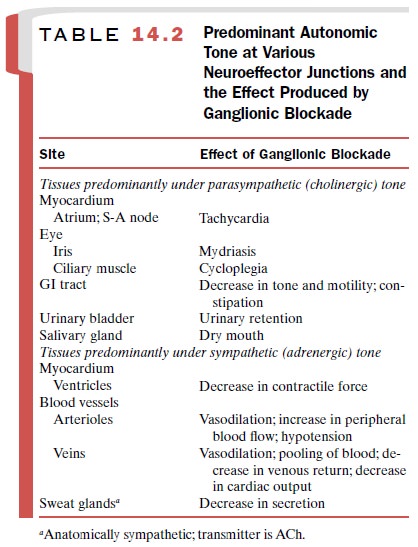Chapter: Modern Pharmacology with Clinical Applications: Ganglionic Blocking Drugs and Nicotine
Ganglionic Blocking Drugs
GANGLIONIC
BLOCKING DRUGS
Although a number of drugs possessing ganglionic blocking
properties have been developed, at the present time they are rarely used
clinically. Other drugs, such as curare,
are not employed as ganglionic blocking agents, although they block ganglionic
nicotinic receptors, es-pecially at high doses. The ganglionic blockers are
still important in pharmacological and physiological re-search because of their
ability to block autonomic ganglia.
Mechanism of Action
Drugs can block autonomic
ganglia by any one of sev-eral mechanisms. They may act presynaptically by
af-fecting nerve conduction or neurotransmitter synthesis, release, or
reuptake. Acting postjunctionally, drugs may affect the interaction between ACh
and its receptor, or they may affect depolarization of the ganglion cell or
initiation of a propagated action potential.
Ganglionic nicotinic blockers
can be divided into two groups. The first group, characterized by nicotine and
related drugs (e.g., lobeline, tetraethylammonium), initially stimulates the
ganglia and then blocks them (discussed earlier). These agents are not
therapeutically useful. The second group of drugs, which have some therapeutic
usefulness but are rarely used, inhibit the postsynaptic action of ACh and do
not themselves pro-duce depolarization, thereby blocking transmission without
causing initial stimulation.
The site of action of many
blocking drugs has been shown to be at the associated ionic channel rather than
at the receptor. Prolonged administration of ganglionic blocking drugs leads to
the development of tolerance to their pharmacological effects.
Pharmacological Actions
In any given tissue, the
magnitude of the response produced by ganglionic blocking drugs depends largely
on the quantity and relative proportion of the total autonomic input coming
from sympathetic and parasympathetic nerves at the time of drug adminis-tration
(Table 14.2). For example, if cardiac vagal tone is high at the time ganglion
blockade is induced, tachycardia results. If heart rate is high, a decrease in
rate may be seen.

The extent of the
hypotension, especially postural hypotension, produced by a ganglionic blocking
agent also depends on the degree of sympathetic tone at the time of drug
administration. For instance, patients with normal cardiac function may have
their cardiac output diminished after ganglionic blockade, while patients in
cardiac failure often respond to ganglionic blockade with an increase in
cardiac output. To date, it has not been possible to develop ganglionic
blocking drugs that have a high degree of selectivity for either sympathetic or
parasympathetic ganglia. However, since these drugs do not affect all of the
various ganglia equally, and since the time at which their peak effect occurs
will vary among the various types of ganglia, some degree of se-lectivity of
action does in fact exist.
Clinical Uses
Hypertensive Cardiovascular Disease
Ganglionic blockers were once widely used in the man-agement of essential hypertension, and they constituted an important advance in the treatment of that disease. Unfortunately, the development of tolerance to these drugs and their numerous undesirable side effects re-sulting from their nonselective ganglion-blocking prop-erties led to a decline in their use. They have now been completely replaced by more effective and less toxic drugs. They do, however, retain some usefulness in the emergency treatment of hypertensive crisis.
Controlled Hypotension
Ganglionic blocking agents
have been used to achieve controlled hypotension in plastic, neurological, and
oph-thalmological surgery. They are most commonly used in surgical procedures
involving extensive skin dissection.
Adverse Effects
All of the responses
summarized in Table 14.2 can be produced by administration of ganglionic
blocking agents. Many of these responses are undesirable effects that limit the
therapeutic usefulness of these agents. Mild untoward responses include
mydriasis, difficulty in vision accommodation, dry mouth, urinary hesitancy,
constipation, diarrhea, abdominal discomfort, anorexia, and syncope. More
serious but less frequent distur-bances include marked hypotension,
constipation, par-alytic ileus, urinary retention, and anginal pain.
Related Topics